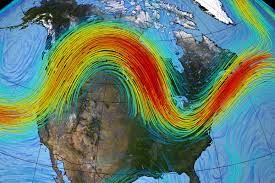How to Calculate Flight Time With Consideration for the Jet Stream ?

Have you ever wondered how the jet stream might be affecting your flight time? Knowing the details about the jet stream and its influence on flying can help you predict, plan for, and understand potential delays. This guide covers everything from basics of the jet stream to understanding how it affects flight times.
Understand the Jet Stream.
The jet stream is an upper level wind system that circles the planet and affects weather. Its influences can be seen in both high and low pressure systems, which impact conditions like temperature, precipitation and wind speed. While it isn't always visible, the jet stream's winds travel at 40 to 116 mph (64 to 187 km/h) - fast enough to significantly affect the flight times of aircrafts!
The jet stream affects the air masses that travel along its path, usually travelling from west to east. When air has to travel around or through the jet stream, it experiences turbulence and a decrease in speed due to the rapid changes in airflow. This can result in higher altitudes and longer flight times for planes traveling beneath it. Additionally, since the jet stream follows a curved path, planes may not always be able to fly directly along their desired route as they try to capitalize on tailwinds and avoid headwinds caused by it. Understanding how the jet stream works is key to navigating aircrafts around it, saving precious time when making long distance flights!
Calculate Flight Time With and Without Wind Considerations.
When determining an airline's flight times, it is important to consider the effect of both tailwinds and headwinds. By factoring in wind speeds at different altitudes along a given route, pilots and dispatchers can calculate the effects of a cross-country flight time more accurately - great for ensuring timely arrivals! In addition to taking into account of wind speed and direction, dispatchers also factor in any other aeronautic considerations such as altitude changes or airspace restrictions.
As far as the jet stream is concerned, high-altitude winds such as those found in jet streams have the power to significantly reduce flight time. For example, wind blowing across or parallel to an aircraft's track can produce a tailwind which would provide an extra push for the plane, allowing it to land earlier than scheduled. Conversely, flying over headwinds can increase total flight time and reduce airspeed. Because of this, pilots must factor in any changes in wind speed during their planning phase when flying across country from one destination to another. Knowing how strong the wind is and which direction it’s blowing will allow them to plan for a more efficient flight with less downtime at altitude.
Monitor the Jet Stream Currents Before Your Flight.
Before you take off, be sure to check the current jet stream along the route you’ll be taking. Monitor the prevailing winds at several different altitudes. This will give you a better idea of how much time might be lost or gained due to the jet stream. When you know where the jet stream lies and what direction it is flowing in, you can better plan your flight time accordingly.
The jet stream is a powerful band of wind that circles around the globe in both hemispheres. It is comprised of three major wind currents that travel from west to east over North America, and are known as the Polar Jet Stream, the Subtropical Jet Stream, and the Tropical Jet Stream. These streams can cause turbulence for aircrafts, which can lead to delays in arrivals and take offs, as well as increased fuel consumption. Depending on where it is along its journey, the jet stream can add or subtract up to an hour on long-haul flights.
Familiarize Yourself With High Altitude Airways & En Route Routings.
When calculating flight time, it is important to consider the routing that you will take when traveling from point A to point B. Many airline routes are determined by several of high altitude Airways. To stay within the jet stream and benefit from its wind speed, try to remain close to these airways when planning a route. It may help you save precious minutes on your trip, albeit at the expense of a slightly longer flight distance.
The jet stream is a powerful wind pattern that moves from west to east and can reach speeds of up to 250 mph at high altitudes. For flight plans that take advantage of the jet stream, pilots must plan their routes so they are aligned with the direction in which it is blowing. Airlines usually design their high altitude routes, which most aircraft fly over, to be parallel with the direction of the wind. When a plane is flying within or along one of these airways, it has the potential benefit of riding on a tailwind — leading to shorter flight times and greater fuel efficiency.
Make Adjustments to Flight Paths When Piloting in Turbulent Winds.
When planning your flight, be mindful and alert of the turbulence brought by the jet streams. Piloting in a turbulent wind can cause significant changes to the altitude of a plane, so adjustments should be made accordingly to ensure that you are flying at an optimal speed and staying within the desired parameters. If turbulence is encountered, try to remain well below the jet stream itself as winds can become stronger further up in this region.
There are various tricks and techniques that can be used to navigate through a jet stream. The first step is to calculate the average wind speed around your flight path which can provide an indication as to how much you should adjust for. Additionally, pilots may opt for different altitudes depending on their current position in relation to the jet stream. By assessing whether or not you are flying ahead of or behind the areas of most turbulence, one may make corrections to the altitude accordingly. Doing so may lead to smoother flying and an overall improved flight time.














